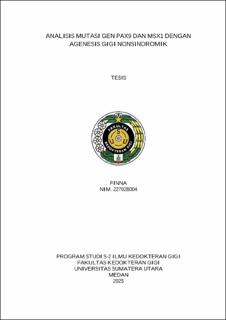Analisis Mutasi Gen PAX9 dan MSX1 dengan Agenesis Gigi Nonsindromik
Analysis of PAX9 and MSX1 Gene Mutations in Nonsyndromic Tooth Agenesis

Date
2025Author
Finna, Finna
Advisor(s)
Primasari, Ameta
Widjaja, Sry Suryani
Metadata
Show full item recordAbstract
Background: Tooth agenesis is the congenital absence of tooth buds.
Nonsyndromic tooth agenesis is the most commonly encountered form. This
abnormal condition can affect tooth development and aesthetic function. The cause
of agenesis is suspected to be influenced by genetic and environmental factors, with
genetics being the primary cause. PAX9 and MSX1 genes are the most frequently
discussed and identified in subjects with nonsyndromic tooth agenesis. Based on
previous research, mutations in PAX9 and MSX1 genes can lead to nonsyndromic
tooth agenesis. Aim: This study aims to analyze mutations in PAX9 and MSX1
genes and their implications on nonsyndromic tooth agenesis. Methods: This study
uses 26 blood samples from nonsyndromic tooth agenesis subjects. The blood
samples were extracted to isolate the DNA which were subsequently sent to the
Faculty of Dentistry, Chulalongkorn University, for sequencing. Demographic data
analysis was performed using SPSS software. Frequency and percentage were
calculated for categorical data, while mean, median, and mode were used for
numerical data. Results: Blood collection was performed on only 13 subjects with
tooth agenesis, and sequencing was conducted on only 4 subjects due to the limited
number of dental agenesis patients and time constraints. The results showed that
only the third sample had a mutation variant in the PAX9 gene with a significant
amino acid change. The other three samples showed the presence of mutation
variants in the PAX9 and MSX1 genes, with a less significant impact on gene
function. Conclusion: There are variant of uncertain significance (VUS) in the
PAX9 gene, and various impact variants found in the MSX1 gene.
Collections
- Master Theses [50]
